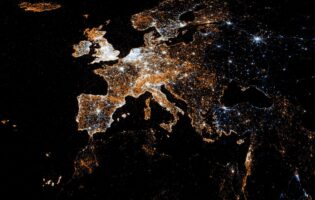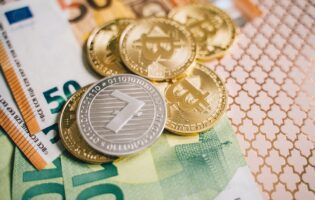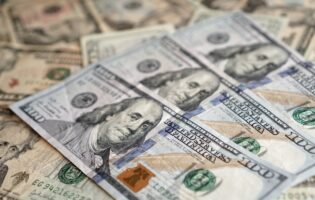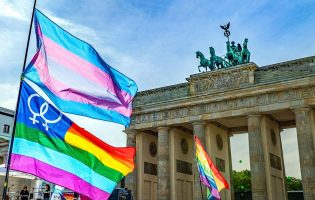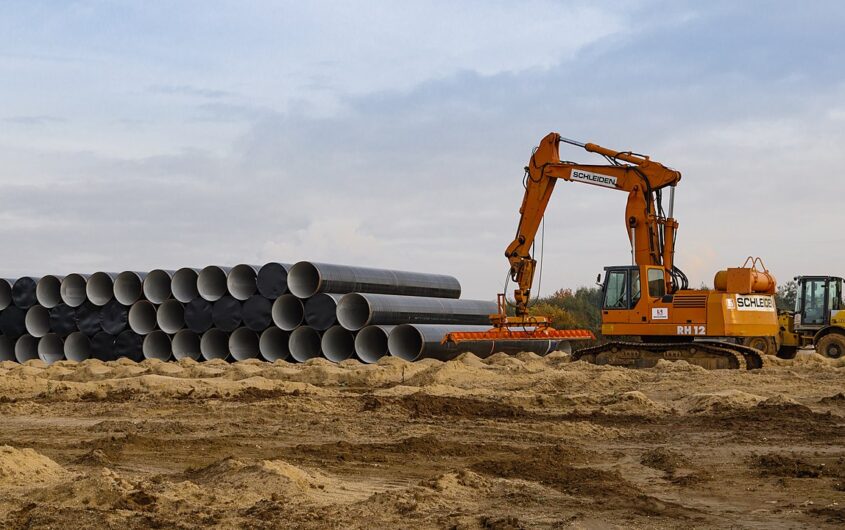
CEphoto, Uwe Aranas via Wikimedia Commons
The Nord Stream 2 Debate and Russia’s Gas Weapon

Stephan Kieninger
Historian
Stephan Kieninger holds a PhD in Modern History from Mannheim University and had previously been a Wilson Fellow at the Woodrow Wilson Center, a postdoc at Johns Hopkins SAIS, a fellow at the Berlin Center for Cold War Studies, and a Senior Researcher at the Federal German Archives.
He is the author of three books on U.S. foreign policy and European security in the Cold War and after: Securing Peace in Europe. Strobe Talbott, NATO, and Russia after the Cold War (Columbia University Press, 2025), The Diplomacy of Detente. Cooperative Security Policies from Helmut Schmidt to George Shultz (Routledge, 2018), Dynamic Détente: The United States and Europe, 1964–1975 (Rowman & Littlefield, 2016), and has received fellowships from the German Historical Institute, the Hoover Institution, and the German Academic Exchange Service.
“Nord Stream 2 was a mistake,” Chancellor Friedrich Merz recently said during his first official visit to the White House. President Donald Trump appreciated these remarks, reminding reporters that he imposed sanctions on the pipeline during his first presidency. In March, it seemed that Trump’s position was less clear, given new rumors about a potential resumption of the pipeline when Trump and Russian President Vladimir Putin had a two-hour phone call over “potential ties of mutual interest in economy and energy.” At about the same time, a U.S. investor with ties to the Republican Party began exploratory talks to buy the Nord Stream 2 pipeline, which would only be possible with a change in U.S. and European Union sanctions. This raised attention on Germany and the EU. Merz took a clear stance during his press conference with Ukraine’s President Volodymyr Zelensky in late May, arguing that “Nord Stream 2 cannot be put back into operation.” Since the pipelines were severely damaged in an explosion in late 2022, several German policymakers have argued in favor of resuming gas flows from Russia to Germany via Nord Stream and the lifting of U.S. sanctions. This would be a disastrous mistake and a return to the dangerous Russia-first policy of the past, undermining NATO’s solidarity and selling out Ukraine. An EU sanctions package introduced by Commission President Ursula von der Leyen on June 10 would ban transactions with the Nord Stream entities. If these sanctions are approved by EU leaders, it would give legal force to the opposition Merz has articulated as chancellor.
Germany’s policymakers had long defended the Nord Stream pipelines against international criticism, based on the dogma that they were a commercial project and had nothing to do with politics. In fact, after the end of the Cold War, Putin weaponized gas supplies in many ways—to dominate Russia’s near abroad, to pressure Central and Eastern Europe, and to weaken the cohesion of the West. The construction of the Nord Stream pipelines in the Baltic Sea was essential to his plans. Nord Stream 1 and 2 connected Russia and Germany over the heads of Ukraine and Poland. In the winter of 2005/2006, after the signing of the contracts for the construction of Nord Stream 1, Putin did not hesitate and began to cut gas supplies to Ukraine. It was his revenge for Ukraine’s Orange Revolution in 2004. He did not see Ukraine as an independent country anyway and was determined to deny the Ukrainians revenues from the transport of Russia’s gas. From Putin’s vantage point, the whole pipeline structure in Ukraine was Russia’s and a product of the former Soviet Union.
Russia’s rulers have long used gas as a weapon. In the late Cold War, Communist Party General Secretary Mikhail Gorbachev cut off gas supplies to punish the independence movement in the Baltic countries. During the Cold War, Soviet leaders employed cuts in gas supplies to enforce discipline in the Warsaw Pact as deliveries of energy and Soviet raw materials were crucial to the heavily industrialized economies of Moscow’s allies in the Soviet bloc. During the Cold War, gas played a crucial role in Soviet relations with the non-communist world. In 1968, the so-called Bratstvo pipeline between Czechoslovakia and Austria was the first gas connection across the Iron Curtain,[i] sparking further interest in Soviet gas imports among other Western European countries.
In the 1970s, the Soviet Union expanded its gas industry and began selling gas to Western Europe and West Germany. It was a win-win. The Soviets gained hard currency to shore up their economy, while the Western states were able to speed up the diversification of their energy supplies after the oil shock in 1973.[ii] In 1970, West Germany’s Ruhrgas signed a twenty-year contract for gas deliveries with the Soviet foreign trade ministry as part of a much larger barter deal under the label “gas for pipe.” Financed by West German banks and underwritten by federal government guarantees, German manufacturers delivered steel pipes in exchange for Soviet gas supplies. The Federal Republic received its first gas deliveries in 1973, and Ruhrgas signed follow-up contracts with the Soviets over long-term gas deliveries until the year 2000. Economic interdependence was seen as a catalyst for Germany’s Ostpolitik. From a German vantage point, trade was supposed to be a stabilizing element in the Cold War helping to normalize relations with the entire Eastern bloc.[iii]
After the end of the Cold War, Putin weaponized gas supplies in many ways—to dominate Russia’s near abroad, to pressure Central and Eastern Europe, and to weaken the cohesion of the West. The construction of the Nord Stream pipelines was essential to his plans.
However, Soviet gas exports to West Germany were the subject of major controversies between the United States and its European allies. In the 1960s, the Kennedy administration succeeded in embargoing the exports of German large-diameter pipe intended for the construction of the Friendship oil pipeline. Things were different in the 1980s when the Reagan administration did not manage to prevent the construction of the so-called Urengoy pipeline for the transport of Siberian natural gas to Western Europe.[iv] Reagan wanted to constrain the Soviet economy and the sale of gas to limit the Soviet military build-up, whereas the Europeans wanted Soviet gas as an inexpensive and reliable source of supply. Finally, Reagan lifted U.S. sanctions after several months of intense transatlantic dispute.
In the late 1980s, Soviet supplies made up about 30 percent of West Germany’s overall gas demand. During the Cold War, Soviet gas did not put Europe at a political disadvantage. Seeking hard currency revenues in a planned economy, the Soviets did not weaponize gas against Germany. The Soviets delivered gas up to the border of Czechoslovakia and West Germany and did not have access to German infrastructure or German customers. The distribution and sale of Soviet gas was firmly in the realm of Ruhrgas, Germany’s leading gas supplier. Germany’s unification and the end of the Cold War led to a further expansion of Russian gas exports to Europe.
After the end of the Cold War, interdependence began to replace geopolitics as a key theme in a globalized world. This was also true in terms of Germany’s changing role in a transformed Europe. The liberalization of the European gas market and Gazprom’s joint ventures with BASF’s Wintershall changed the whole context of Germany’s energy market. Wintershall and Gazprom formed a new gas trading business, introduced competition to the gas market, and built thousands of kilometers of new gas pipelines in a “gas war” with Ruhrgas, the market leader, whose dominance over the German market began to dwindle. Over time, Gazprom gained access to Germany’s critical gas infrastructure in return for Winterhall’s acquiring large stakes of Russian state-owned gas fields in Western Siberia in 2006. The share of German gas imports from Russia grew to 55 percent of Germany’s overall gas consumption by 2022.
Despite the formal cancellation of Germany’s strategic partnership with Russia after the annexation of Crimea and Eastern Donbas in 2014, the German-Russian energy relationship continued. Natural gas trade seemed to be a win-win, and successive German governments adhered to the dogma of trying to separate trade and politics. Germany only began to uncouple from Russian gas after the start of Russia’s full-scale war in Ukraine in 2022. In the future, the challenge will be to sustain the Zeitenwende in Germany’s foreign policy. Germany’s former Green foreign minister Joschka Fischer was right when he called Nord Stream 2 “a strategic mistake,” and wondered: “Is it really too expensive to embargo Russian gas?”
[i] Per Högselius, Red Gas: Russia and the Origins of European Energy Dependence (New York, NY: Palgrave Macmillan, 2013).
[ii] Werner D. Lippert, The Economic Diplomacy of Ostpolitik: Origins of NATO’s Energy Dilemma (New York, NY: Berghahn Books, 2010).
[iii] Jeronim Perovic, Fuel and Power: Energy, Trade, and Russian Foreign Relations from Lenin to Putin (Cambridge: Cambridge University Press, 2024).
[iv] Stephan Kieninger, The Diplomacy of Détente: Cooperative Security Policies from Helmut Schmidt to George Shultz (New York, NY: Routledge, 2018).



